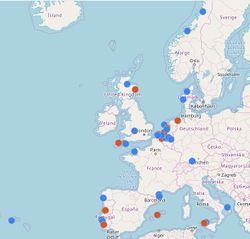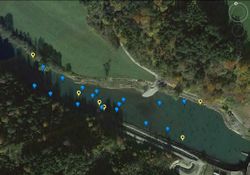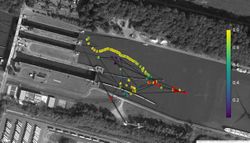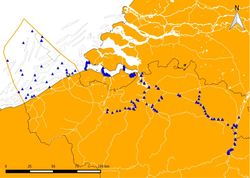Radio telemetry
Quick summary

Developed by:
Date:
Type: Method
Suitable for the following [[::Category:Measures|measures]]:
Introduction
Radio telemetry is mainly used in freshwater (shallow streams and rivers) with a conductivity of < 500-1000 µSiemens/cm. A radio transmitter emits electromagnetic energy in the radio frequency range (between 30-300 MHz) and provides a possibility for remotely locating a fish. Digitally coded transmitters emit a unique code. A system can operate up to 1000 coded transmitters on one single frequency.
It is a gear intensive technique with the following components:
- Transmitter, emitting the signal, attached to the fish, with battery and an antenna (Figure 1)
- Mobile or fixed receiving antenna, capturing the radio signal, different types available; often loop or Yagi antenna are used.
- Receiver, converting the radio signal into an electronic/audible form in order to identify the tagged fish (Figure 2)
- Data logger, operates the receiver when the operator is absent
- Cables/connectors connect the antenna to the receiver
The transmitters should be adjusted to the size of fish and the study goal. The transmitter weight should not exceed 2 % of the fish weight. Different sensors can record temperature, depth, and pressure. Miniaturization made transmitters with 0.2 g possible. Therefore small fishes (12-15 cm total length) can be equipped with these tiny transmitters.
The transmitters are implanted into the body cavity of the fish (Figure 3). Gastric (oesophagus) insertion or external attachment may be possible. The conductivity of the water and the depth of the transmitter in the river are the most critical parameters in detecting the radio signals.
Application
Radio telemetry is a standard tool for the study of spatial ecology and migration of fishes. It can be applied for a variety of fish migration studies. The passage corridor at a hydropower plant can be evaluated and information is gathered how the fish is approaching the site. The searching phase in front of a hydropower plant can be documented for downstream and upstream migrations.
Stationary and mobile tracking are often used. Stationary tracking continuously tracks a signal, but its application is limited to specific sites. Fish presence or absence at a site, and passage and movement rates between sites can be detected (Eiler, 2012). Mobile tracking allows the survey of an extended area.
The application for radio telemetry at hydropower plants is mainly detecting passage routes and linear migrations in a river system. However, acoustic telemetry (section 1.2) became very popular and is more suitable for studies with the goal of documenting the detailed behaviour patterns of fishes in front of a hydropower plant (forebay). There are certain advantages and disadvantages for acoustic and radio telemetry. Both methods are adequate depending on the study objectives.
Radio telemetry is applied worldwide. Beeman et al (2012) published a comprehensive study on the effects of hydroelectric dams on fish populations on the Columbia River and on the Snake River. The downstream migration of Chinook salmon and anadromous rainbow trout at different sites were extensively documented.
Radio telemetry studies will be applied within the FIThydro project in the Aare River (HP Bannwil) to study the migration corridor and the timing of the migration. Mainly cyprinid fish species will be tracked. The main question is if fish are using the spillway corridor or if they migrate with the main flow through the turbine intakes. On the whole, the downstream migration of cyprinid fish species at hydropower plants has been incompletely studied so far and the Bannwil Test Case should contribute to a better understanding of cyprinid fish migration.
Other information
Acoustic fish telemetry suppliers worldwide:
- ATS, 470 First Avenue NW, Isanti, MN 55040, USA
- HTI, 715 NE Northlake Way, Seattle, WA 98105: recent partnership with Vemco
- Lotek Wireless Inc., 115 Pony Drive, Newmarket, Ontario, Canada L3Y 7B5
- Thelma Biotel, Sluppenveien 10, 7037 Trondheim, Norway, EU
- Sonotronics, 3169 S Chrysler Ave, Tucson, AZ 85713, USA
- Vemco, 20 Angus Morton Drive, Bedford, Nova Scotia, Canada B4B 0L9
Hydrophones can differ regarding the frequency used, the ability to measure other variables (tilt, temperature, …), whether it is cabled or not, etc. The price for one submersible hydrophone ranges from 1.000 to over 3.000 € (without VAT). Tags are available in an endless number of different settings and sizes. The price range of acoustic tags is between 180 and 500 €. A lot of other gear like portable hydrophones, automatic acoustic release systems, remote communication, etc. are available these days.
Relevant literature
Some examples of 1D acoustic studies using different suppliers of acoustic gear:
- Bass, A. L., T. O. Haugen, & L. A. Vøllestad, 2014. Distribution and movement of European grayling in a subarctic lake revealed by acoustic telemetry. Ecology of Freshwater Fish 23: 149–160.
- Behrmann-Godel, J., & Eckmann, R., 2003. A preliminary telemetry study of the migration of silver European eel (Anguilla anguilla L.) in the River Mosel, Germany. Ecology of Freshwater Fish 12: 196–202.
- Besson, M., T. Trancart, A. Acou, F. Charrier, V. Mazel, A. Legault, & E. Feunteun, 2016. Disrupted downstream migration behaviour of European silver eels (Anguilla anguilla, L.) in an obstructed river. Environmental Biology of Fishes .
- Breine, J., I. S. Pauwels, P. Verhelst, L. Vandamme, R. Baeyens, J. Reubens, & J. Coeck, 2017. Successful external acoustic tagging of twaite shad Alosa fallax (Lacépède 1803). Fisheries Research 191: 36–40.
- Bultel, E., Lasne, E., Acou, A., Guillaudeau, J., Bertier, C., & Feunteun, E. (2014). Migration behaviour of silver eels (Anguilla anguilla) in a large estuary of Western Europe inferred from acoustic telemetry. Estuarine, Coastal and Shelf Science, 137(0), 23-31. doi:http://dx.doi.org/10.1016/j.ecss.2013.11.023
- Hayden TA, Holbrook CM, Fielder DG, Vandergoot CS, Bergstedt RA, Dettmers JM, et al. (2014) Acoustic Telemetry Reveals Large-Scale Migration Patterns of Walleye in Lake Huron. PLoS ONE 9(12): e114833. https://doi.org/10.1371/journal.pone.0114833
More than 1000 research papers on Vemco acoustic telemetry research can be consulted via https://vemco.com/publications-database/.
Hundreds of papers that used Lotek gear can be found here: http://www.lotek.com/search
Examples of 2D and 3D research outputs:
- Andrews, K. S., N. Tolimieri, G. D. Williams, J. F. Samhouri, C. J. Harvey, & P. S. Levin, 2011. Comparison of fine-scale acoustic monitoring systems using home range size of a demersal fish. Marine Biology 158: 2377–2387.
- Espinoza, M., T. Farrugia, D. Webber, F. Smith, & C. Lowe, 2011. Testing a new acoustic technique to quantify fine-scale, long-term fish movements. Fisheries Research 108: 364-371.
- Fowler, A. J., C. Huveneers, & M. T. Lloyd, 2017. Insights into movement behaviour of snapper (Chrysophrys auratus, Sparidae) from a large acoustic array. Marine and Freshwater Research 68: 1438–1453.
- Roy, R., L. Westrelin, E. Tissot, E. De Oliveira, & C. Argillier, 2014. Activity patterns of three piscivorous species in a reservoir studied with the Vemco Positioning System. 144ème réunion annuelle de l’American Fisheries Society 18 p.
- Vergeynst, J., R. Baeyens, I. Pauwels, T. De Mulder, I. Nopens, & A. Mouton, 2016. The behaviour of downstream migrating European eel at sluices and turbines. http://lib.ugent.be/catalog/pug01:8075115.
- Williams-Grove, L. J., & S. T. Szedlmayer, 2017. Depth preferences and three-dimensional movements of red snapper, Lutjanus campechanus, on an artificial reef in the northern Gulf of Mexico. Fisheries Research 190: 61–70.


